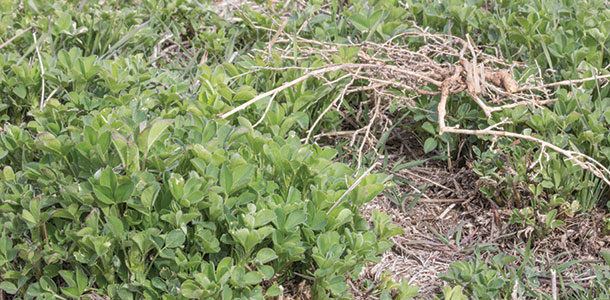They told me they’re pursuing potential partnerships on haying equipment, and some are putting buy-sell arrangements into place with dairy or livestock operations to justify adding alfalfa acres this spring.
Recently, I received an email from a farmer stating that his family is expanding its beef enterprise. He went on to write that his family put a large portion of their alfalfa acres into row crops when corn and soybean prices were strong.
Now, with the cyclical change of lower commodity prices combined with more cattle on feed, they’re planning to seed more alfalfa acres this spring.
Another producer in southern Minnesota, who currently grows corn and soybeans, called to talk about the merits of raising alfalfa. Our conversation reminded me about the many benefits of making alfalfa part of a crop rotation including return on seed investment (ROI), enhanced productivity of crop following alfalfa, better disease management and soil health.
ROI
Alfalfa used to be the most expensive seed to purchase, but that’s no longer the case as today’s alfalfa seed provides solid returns for three or four years. Modern alfalfa varieties and hybrids are more productive and durable, thanks to genetic advancements.
Research reveals a specific alfalfa variety’s responsiveness to varying soil conditions, such as extreme wet soil, disease-prone soil, stress-prone soils and high-salt soils.
We can do a better job of placing alfalfa in the correct environment if we understand soil’s limitations. To further increase our chances of maximizing tonnage, we can develop a designer plant diet to help compensate for soil limitations.
Designer alfalfa plant food diets include a balance of many factors such as proper soil pH and adequate fertilizer including micro-nutrients. Application timing is critical to recognize the largest return on your fertilizer investment.
Keep the following in mind for annual fertilizer applications on alfalfa:
- Fertilize immediately after harvest and before regrowth resumes but avoid fertilizer contact with wet foliage.
- Top-dress following the first cutting of alfalfa to stimulate regrowth for second and third cuttings or top-dress in early September to increase winter hardiness.
- Avoid top-dressing plants when soils are soft, such as early spring, to avoid physical damage to alfalfa crowns.
- Split the application to avoid salt damage if using more than 500 pounds per acre of fertilizer material in any year. Base fertilizer purchases on cost per unit of plant food provided.
- The season prior to alfalfa stand establishment is a good time to add appropriate fertility so it has time to get into soil solution, especially when trying to modify soil pH.
Tillage prior to alfalfa stand establishment is the last opportunity to incorporate nutrients like nitrogen, phosphorus, potassium and sulfur during the life of the stand. Adding immobile nutrients drastically increases their effectiveness.
Recyclable nutrients from manure may be added at this time if proper weed control practices are followed.
In recent years, on-farm trials have shown a positive return from higher alfalfa seeding rates. Traditionally, most growers seed in the range of 15 to 18 pounds per acre. In 2012, one grower I work with in western Iowa started seeding at 25 pounds per acre.
He weighed everything that came off his field and found the additional tonnage more than paid for the extra seed. Additionally, he discovered he had thicker and more robust stands the following season with increased seeding rates.
Today, this grower seeds at a rate of 35 pounds per acre because he’s seeing increased tonnage. This same test has been replicated on a Wisconsin farm during the past two seasons with similar positive results.
There are still unknowns from higher seeding rates including potential for increased disease and the need for more plant nutrition. However, it may be worth conducting experiments on your own acres. Simply seed part of a field at your current rate and then increase the seeding rate on another part of the field. Then collect and compare yield results.
Crop productivity
To help ensure you’re applying the right balance of micro-nutrients, consider using precision soil and fertility systems. Tissue sampling, for example, has gained popularity in recent years because it more accurately represents plant nutrition by showing real-time plant nutrient balance.
Science has revealed there is a delicate balance of approximately 16 essential elements that maximize yield capacity, but presently soil samples don’t test for every essential element. That means we likely haven’t been replacing them either.
Most growers who diligently take soil samples, grid samples and plant tissue samples have experienced the positive plant health and yield advantages from precision testing and designer plant diets.
Emerging GPS and computer-based crop management programs assist farmers with tracking yield and economic benefits by managing this newly found data.
Depending on the lab, some reports for plant samples reveal the concentration of nitrogen (N), phosphorus (P), potassium (K), calcium (Ca), magnesium (Mg), sulfur (S), zinc (Zn), manganese (Mn), boron (B), copper (Cu), iron (Fe), aluminum (Al) and sodium (Na) within the plant.
Soil samples submitted with the plant sample will be analyzed for pH, organic matter, P and K, as well as special soil test results. Nutrient levels will also be interpreted for soil and plant samples to identify any nutrient issues and potentially offer recommendations. It’s important to note that nutrients can then be soil-, seed- and foliar-applied.
A good stand of alfalfa provides excellent alfalfa nitrogen credits that cost you nothing. Alfalfa also has a strong taproot, which penetrates root-restrictive hardpan barriers, allowing the following crop’s roots to penetrate much deeper into the earth for nutrients.
Soil health and disease management
Another advantage of rotating with alfalfa is that the soil has an opportunity to rest and restore itself from residue that may linger from herbicides that had been sprayed when corn or soybean crops were grown.
Breaking the cycle of commonly used row-crop herbicides for three to four years helps slow the pathway to the growing concern of weed resistance. With an aggressive and consistent cutting, weeds are typically managed in alfalfa without the quantity of herbicides used in row-crop production.
This may seem like a small benefit, but disease management in corn production is becoming a large concern. Rotating into alfalfa production helps reduce the spread of corn diseases from old, decaying residue into newly growing corn.
In addition to reducing the potential for disease, alfalfa offers other environmental benefits. Reduced tillage in an alfalfa field promotes less breakdown of soil structure; plus, alfalfa plants provide habitat for beneficial insects and other wildlife.
Alfalfa is an excellent cover crop and reduces runoff and soil erosion. Alfalfa also provides another manure management option for livestock producers.
Of all factors, a critical stage of production is stand establishment. Seed treatments for alfalfa have gone through some intensive modernization. Simply put, there are new seed treatment packages that will better equip each seed for its best possible success of emerging fast.
Because the fragile and tiny alfalfa seed is placed in a rugged and tough environment, seed treatment acts as an insurance policy to help it emerge faster and grow stronger. Applying seed treatment to alfalfa is a growing trend since more seed-treatment companies are getting products labeled for use on alfalfa seed.
Another growing trend is selecting alfalfa seed that is best suited for the environment and to specific farm needs. Today’s alfalfa growers have more choices than ever:
- Glyphosate-resistant alfalfa can clean up fields with heavy weed infestations.
- Disease-resistant alfalfa varieties carry resistance to aphanomyces Race 2 to maintain plant health.
- Salt-tolerant alfalfa is bred to handle unique challenges found in saline soils.
- Hybrid alfalfa offers top quality and fast regrowth, which is especially critical for dairy operations.
- Leafhopper-resistant alfalfa boasts a natural leafhopper barrier.
- Branch-rooted alfalfa maintains the fragile root system in challenging wet soils.
Alfalfa is a great crop of choice, regardless of current corn or soybean prices. There are a lot of financial and environmental reasons to make alfalfa a part of your regular crop rotation.
Similar to row-crop production, top alfalfa production becomes a combination of many management details, including a deeper understanding of soils, seed choices, seed treatments, plant nutrition and water. FG
PHOTO
Photo coutesy of Lynn Jaynes

- Corey Catt
- Forage Product Manager
- Latham Hi-Tech Seeds














